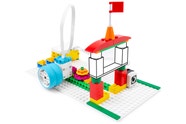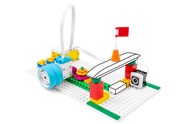Snack Stand
Oh, no! Daniel dropped his snack. Help him to get a new one from the snack stand.

Prepare
- Review the Snack Stand lesson in the LEGO® Education SPIKE™ App.
- If you feel that it would be beneficial, pre-teach these related vocabulary words: effective, serve and tool.
- Consider the abilities and backgrounds of all your pupils. Differentiate the lesson to make it accessible to everyone. Please refer to the Differentiation section below for suggestions on how to do this.
- If time permits, plan and facilitate the maths extension. Please refer to the Extension section below for more information.
Engage
(Whole Class, 5 Minutes)
- Facilitate a quick discussion about the importance of testing to make sure that an object works as it should.
- Talk with your pupils about objects that must work properly during a meal.
- Ask questions like these: How could you test to make sure a table is flat so that your food won’t roll off? If the table isn’t flat, what could you do to fix it?
- Introduce your pupils to the story’s main characters and the first challenge: serving another snack to Daniel.
- Distribute a brick set and a device to each group.
Explore
(Small Groups, 30 Minutes)
- Have your pupils use the LEGO® Education SPIKE™ App to guide them through their first challenge:
- Create and test the program that serves another snack to Daniel when he shows his blue ticket to the Colour Sensor.
- Have your pupils iterate and test their models to complete the next two challenges in the app:
- Change the program to improve the snack stand.
- Upgrade the snack stand for Daniel. Make sure that he can still reach his snack.
- You can find coding and building help in the Tips section below.
Explain
(Whole Class, 5 Minutes)
- Gather your pupils together to reflect on their completed challenges.
- Ask questions like these: What did you do to upgrade the snack stand? How did you make sure that Daniel was still able to get his snack from the upgraded snack stand?
Elaborate
(Whole Class, 5 Minutes)
- Prompt your pupils to discuss and reflect on the importance of testing a prototype to ensure that it works as intended.
- Ask questions like these: Why is it important to test and make sure that your prototype works as you’d like it to? What happens when your upgraded prototype fails and doesn’t work as you’d like it to?
- Have your pupils tidy up their workstations.
Evaluate
(Ongoing Throughout the Lesson)
- Ask guiding questions to encourage your pupils to ‘think aloud’ and explain their thought processes and reasoning in the decisions they’ve made while building and programming their models.
Observation Checklist
- Measure your pupils’ proficiency in testing an upgraded prototype to ensure that it works as they’ve intended.
- Establish a scale that suits your needs. For example:
- Requires additional support
- Can work independently
- Can teach others
Self-Assessment
Have each pupil choose the brick that they feel best represents their performance.
- Yellow: I think that I can test an upgraded prototype to make sure it
does what I’d like it to. - Blue: I can test an upgraded prototype to make sure it does what I‘d
like it to. - Green: I can test an upgraded prototype to make sure it does what I’d
like it to, and I can also help a friend do it.
Peer Feedback
- In their small groups, have your pupils discuss their experiences working together.
- Encourage them to use statements like these:
- I liked it when you…
- I'd like to hear more about how you…
Tips
Coding Tips
- After your pupils have completed their first challenge, they'll be provided with three Inspiration Coding Blocks, which will help them to modify their programs.
- The Inspiration Coding Blocks are intended to spark their imaginations as they experiment to find their own solutions.




Model Tip
- After your pupils have completed their second challenge, they’ll be provided with three Inspiration Images and an open-ended prompt, which will help them to improve their models.
- The Inspiration Images are meant to help spark their imaginations as they experiment and change their models.




There are no specific building instructions for this challenge.
Differentiation
Simplify this lesson by:
- Shortening the lesson to include only the first challenge
- Selecting one Inspiration Image to help your pupils to change their models
Increase the difficulty by:
- Adding other colours for the Colour Sensor to react to
- Adding more menu items for Daniel to order and eat
Extension
- Have your pupils use the data that they’ve collected from the snack stand to create a bar graph on paper or using different manipulatives. Guide your pupils in a discussion about which colour was used the most, least, etc.
If facilitated, this will extend beyond the 45-minute lesson.
Maths: National Curriculum Maths Ma2/4.1 Statistics
Ma2/4.1a Interpret and construct simple pictograms, tally charts, block diagrams and tables.
Ma2/4.1b Ask and answer simple questions by counting the number of objects in each category and sorting the categories by quantity.
Ma2/4.1c Ask and answer questions about totalling and comparing categorical data.
Teacher Support
The pupils will:
- Practise testing prototypes to ensure that they meet a need
- Modify and remix a solution
- Practise helping a story character
- Describe key ideas or details from a text
(one for every two pupils)
- LEGO® Education SPIKETM Essential Set
- Device with the LEGO® Education SPIKE™ App installed
National Curriculum
Design and Technology
DT1/1.2b
- select from and use a wide range of materials and components, including construction materials, textiles and ingredients, according to their characteristics
DT1/1.3a - explore and evaluate a range of existing products
DT1/1.3b - evaluate their ideas and products against design criteria
English
En2/1g
- use spoken language to develop understanding through speculating, hypothesising, imagining and exploring ideas
En2/2.2d - explain and discuss their understanding of books, poems and other material, both those that they listen to and those that they read for themselves.
Maths
Ma2/4.1
- Statistics
Ma2/4.1a - interpret and construct simple pictograms, tally charts, block diagrams and tables
Ma2/4.1b - ask and answer simple questions by counting the number of objects in each category and sorting the categories by quantity
Ma2/4.1c - ask and answer questions about totalling and comparing categorical data.